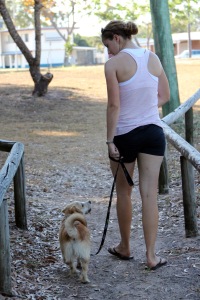There’s a great saying in the dog training world, which goes something like this: “In dog training, jerk is a noun not a verb”. In other words, jerk should not be an action that you take when trying to teach your dog leash manners (or any other skills for that matter).
Traditionally, dogs are taught to walk beside their owner by praising them in position and giving a leash pop/jerk/tug/tap/correction/you-name-it when they pull forward on the leash. There is an assortment of collars, leads, and harnesses that are designed to help that jerk be felt more effectively by the dog, which should thus speed up the learning process.
I’ll start by saying i have been there, done that. Like most people, i was taught to jerk on my dogs leash when he pulled. We tried assorted harnesses, head collars, and training collars, all to no avail. Why doesn’t it work?
If i walked up to you and leaned against your side, you would lean back and resist (of course you would, otherwise you’d fall over). This is our opposition reflex, and our dogs have it too. When the leash goes tight, they oppose that force and pull ahead. Combine this with all the pee-mail to be checked, sights to see, and dogs to greet when you pull, and you have a recipe for some very well rewarded behaviour. Pulling works.
Now, if you apply a leash jerk with exquisite timing and precise force, you should be able to stop your dog pulling. The problem? Most owners (and trainers for that matter) do not have the physical training skills to apply that kind of timing. The result? Our intended message doesn’t get through, and you get a dog that still pulls. This is why you will see dogs who continue to pull to the point of injury regardless of whether they are wearing a check chain or other training aid.
So what is the solution? Loose-lead walking is a behaviour that can be easily taught with positive reinforcement when we set our pets up for success, and build the behaviour in baby steps. We love to get people started with their puppies at Puppy Preschool, but it is never too late to start.
Start in a location with minimal distractions (such as your backyard) and practice moving one or two steps away from your dog and rewarding them when they follow. You can then build up the steps you take between treats, and select the position that you specifically want to reward (left or right side, slightly forward or behind). My own criteria for loose lead walking is that Wilbur can walk on either side of me, as long as the leash buckle hangs down and he crosses sides behind me (so i don’t step on him). When you have mastered the loose-lead walking in the yard, move out to the front yard, start tackling short trips up the street. As you increase the challenge, increase the rate of reward again. With time the walk itself becomes the reward, and the position is maintained through the foundation training you did in the beginning.
For a great poster on teaching loose-lead walking check out Lili Chin‘s work.
So why bother? It sounds like a lot of work! The great thing about teaching any behaviour with positive reinforcement is that your dog will develop a desire to learn and to participate with you during training. I want my dog to walk beside me because they love to be there, not because they’re afraid to move. Better yet, if your timing is off with positive reinforcement you will see it in your dogs behaviour. You wanted your dog beside you, but they’re slightly in front? Change when and where you reward. This is a far less stressful fall out for your dog that the fall out of a poorly timed leash jerk.
When i take my dog for a walk i want him to love being out with me, and to enjoy using his full range of senses to explore the world. My criteria is only that the lead is slack, with that met he is free to sniff, look, listen, and enjoy! Train smart, not tough!

